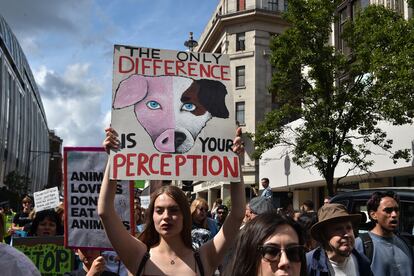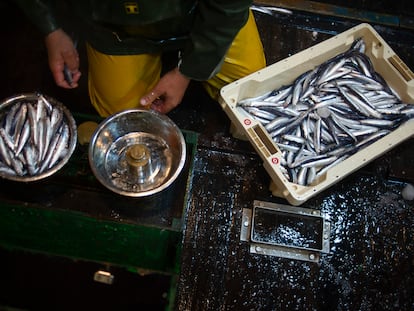I’m vegan, but sometimes I eat meat: What is happening to veganism?
The movement is torn between upholding a strict posture against the consumption of living beings and incorporating people with a plant-based diet who have the odd piece of cheese

Veganism is on the rise. We are surrounded by vegan substitutes for milk, shampoos, donuts and tacos. In January, Kentucky Fried Chicken launched a vegan version of its battered chicken, which consists of a mixture of mushrooms with 11 types of herbs and spices. However, something doesn’t add up: vegans and vegetarians represent a tiny fracture of the general population. What’s behind this imbalance?
Being vegan is a challenge. We live in a meat-based society, which has given risen to carnism, a term coined by U.S. social psychologist Melanie Joy to describe a world where meat is the norm and included in most menus. Another difficulty is humans don’t like to stand out: we tend to follow the behavior of our social group, according to Canadian social psychologist Steven Pinker. That’s why giving up meat can be especially hard.
In Justice for Animals, renowned U.S. philosopher Martha Nussbaum writes that she eats fish because she believes that fish do not develop life plans and killing them painlessly, if they have lived in freedom, is not reprehensible. “I’m less worried about doing this than consuming 70 grams of protein daily to stay healthy at my age (73). It is something I question myself about and with which I am not satisfied, but it is the point I am at.”
The truth is that a large number of people feel uncomfortable ordering a separate meal, or bringing their own vegan food to a family gathering. Not to mention turning down their grandmother’s homemade, butter-filled cookies. As a result, a high percentage people who start a vegetarian or vegan diet end up abandoning it. Activism has its limits. In 2014, Faunalytics surveyed 11,500 consumers in the United States and Canada who were starting a vegan or vegetarian diet and found that, within six months, 84% of them had given up.
In 1980, the main reason for going vegan was animal welfare, but today, the leading reasons are for personal health and the environment. And this, for some activists, has many implications. “The difference is that one is altruistic and other is less so,” says Nuria Almirón, a Spanish activist, researcher and professor in the department of communication at the Pompeu Fabra University. “The latter have very weak ethics. Helping others is what gives you inner strength. Many people believe that they are taking the step out of genuine concern for the environment, that they are doing it for the planet, but in reality they are doing it because they are very scared to think that all of this, and our lives, is going to end. There is a self-centered component.” Almirón adds that the meat sector lobby uses “fear tactics,” addressing health concerns that also scares people off veganism.
Estela Díaz Carmona, a Spanish lawyer, has been vegan since she was a teenager. When she started to take an interest in veganism, she immersed himself in the works of philosophers such as Peter Singer, the author of the groundbreaking book Animal Liberation (1975) and Tom Regan (The Case for Animal Rights). She was trying to understand the reasons for our tendency towards speciesism, which discriminates against animals because they are considered inferior species to us.
Later, inspired by her activism, she decided to study eating behaviors. “I came across consumers who stated: ‘I’m vegan, but sometimes I eat cheese.’ But that’s not being vegan!” Before, says Díaz Carmona, activists were steeped in the foundations of veganism. Now there is much more “confusion,” she says “Veganism is the dietary manifestation of an ethical struggle. It is a political-moral movement and we are supposed to be part of this current. I don’t understand why some people do not understand that this is not being vegan.”
In 2016, the Spanish consulting firm Lantern decided to start studying vegans. So far they have presented four reports. In 2021, they concluded that there was “a tsunami” of veggie consumers. This “veggie” label includes vegans, vegetarians and flexitarians — people who largely consume vegetables and legumes, but who also eat meat, including red meat, between two and four times a month. Based on their survey, carried out between 1,000 and 1,200 people, there are around 4.5 million veggie consumers in Spain, of whom 9% (3.5 million) are flexitarian. This trend is seen across the Western world: in the United States, for example, it is estimated that 15% of the population is flexitarian. “If we only talked about vegans and vegetarians we would be referring to a very niche group of the population,” says Jaime Martín, the director of Lantern.

According to the surveys, young people aged between 18 and 25 are most likely to follow a plant-based diet. But interestingly, they are also more likely to eat a lot of meat as they consider it “part of their culture and their identity,” says Martín.
Given the challenges of following a strict vegan diet, there is debate in the movement about whether people who are interested in reducing their meat consumption should also be included. After seeing the high percentage rate of people giving up on veganism, Canadian activist Jo Anderson, Research Director at Faunalytics, encouraged activists to put aside a puritanism that, in her opinion, makes people feel like failures if they slip up. According to Anderson, “‘absolutism’ or ‘abolitionist’ approach to advocacy is often partly why those who try the diet slip back into eating animal products.”
In 2017, Belgian activist and strategist Tobias Leenaert published How to Create a Vegan World: a Pragmatic Approach, a work that shocked many vegan activists, who considered Leenaert “a traitor,” he explained. His message is that, in a society like ours, it is better to have a more “pragmatic” approach to veganism. In other words, if the ultimate goal is to reduce the harm against animals, there are better chances of achieving that if lots of people reduce their meat consumption, rather than if a tiny proportion of people completely cut out meat products from their diet.
The Flemish activist is in favor of accepting the aspiring vegan who’s addicted to the melted cheese on pizza, of eating the lasagna that’s accidentally been made with non-vegan pasta sheets and of witholding judgement of the vegan friend who eats sushi once a year because it’s part of a tradition they have with their uncle. “It’s easy to be a philosopher and recite truths about the rights of animals. It’s much harder to get your hands dirty and do the right things at the right time truly to make a difference,” he writes in the book. “That’s the art of high-impact advocacy.”
Melanie Joy — the creator of the concept of carnism who wrote Why We Love Dogs, Eat Pigs and Wear Cows — sees a big difference between people who are 100% vegan and those who are 99%, arguing that the latter have not embraced a vegan mindset. “Our mind is carnistic, we can’t forget that. This dominant culture is made to predominate, and veganism is a challenge to the usual diet,” she explains. “Vegans, who are the ones who oppose it, are considered emotional, problematic, sentimental, arrogant… And all these labels can be very hard to manage.” Joy lists some of the obstacles faced by vegan consumers: economic accessibility, since many meat products “are subsidized,” and the difficulty of buying fresh vegetables within a reasonable distance.

The social psychologist is not concerned that there are people who describe themselves as vegans and continue to eat meat. She believes that few vegans do this and argues that language is important. “Why are there so many feminists? In the 1970s, this word was used with pride. But there was a reaction against it and feminism became a dirty word, and we still sometimes fight against that contrary view. At first, queer was a negative word, but then it was embraced.”
Ed Winters is a young British vegan, who says that as a teenager he was a big fan of Kentucky Fried Chicken, until he saw a documentary about how chickens were dismembered — an awakening he recounts in his book This Is Vegan Propaganda.
Winters is concerned that the rise of veganism will dilute what the movement really stands for. “Meat consumption has different impacts: on our health, ethics, environmental justice... Because it has so many meanings, it can be many things to different people. I think it’s good that the word ‘vegan’ is used and seen as something normal, but the word could lose its true meaning. And while I don’t think we’ve reached the point where we need to be concerned, we are at a time where for many, vegan is not necessarily what it should be, which is ‘I want to help animals and in doing so reduce my impact on the Earth with my dietary decisions,’” he says in a video call.
According to Winters, the key to being more lenient with people who reduce their meat consumption without going 100% vegan is that it increases acceptance of veganism. Even if these consumers don’t see it as the answer needed to bring about a change in our behavior, he believes they would understand that change needs to happen for us to live in a more ethical and sustainable world. “When people realize that there has to be a change, it’s easier for them to conclude that perhaps that necessary change is veganism.”
“It is more important that all products be labeled vegan correctly than it is to label people,” says Carrie P. Freeman, a professor of communication at the University of Georgia in Atlanta, who is vegan. In an “imperfect” world like ours, you cannot be an ideal vegan, she says. But we can try to avoid animal exploitation to the best of our ability, be environmentally responsible, and want our communities and governments to make these ethical practices easy and accessible. “On my campus there was a movement asking for 50% of the menu to be vegetarian, but, unfortunately, it did not prosper. Nowadays, they only offer you one vegetarian dish on the menu. A generalized or more widespread global commitment is needed.” However, she highlights the work of the Default-Veg initiative, which seeks strategies to promote a plant-based diet.
While Leenaert may be seen as a traitor to some in the vegan movement, his approach has helped achieve something unprecedented: the Belgian government has funded a vegetarian project in the city of Ghent. Since 2009, every Thursday, the town goes vegetarian, with every restaurant offering 100% meat-free menus. Recently, the city’s public schools have joined the initiative and every Thursday, students have a meat-free menu made up of vegetables, cereals, and legumes.
According to Leenaert, we must take into account the effect that our behavior has on others. The more veganism is presented as doable and fun, rather than strict and complicated, the more people will try to be vegan, he says. “And if someone finds it difficult to follow this diet, then make an exception,” he says by videoconference from the Belgian city. “If we allow exceptions, people will want to try it. It’s that simple.”
Sign up for our weekly newsletter to get more English-language news coverage from EL PAÍS USA Edition
Tu suscripción se está usando en otro dispositivo
¿Quieres añadir otro usuario a tu suscripción?
Si continúas leyendo en este dispositivo, no se podrá leer en el otro.
FlechaTu suscripción se está usando en otro dispositivo y solo puedes acceder a EL PAÍS desde un dispositivo a la vez.
Si quieres compartir tu cuenta, cambia tu suscripción a la modalidad Premium, así podrás añadir otro usuario. Cada uno accederá con su propia cuenta de email, lo que os permitirá personalizar vuestra experiencia en EL PAÍS.
¿Tienes una suscripción de empresa? Accede aquí para contratar más cuentas.
En el caso de no saber quién está usando tu cuenta, te recomendamos cambiar tu contraseña aquí.
Si decides continuar compartiendo tu cuenta, este mensaje se mostrará en tu dispositivo y en el de la otra persona que está usando tu cuenta de forma indefinida, afectando a tu experiencia de lectura. Puedes consultar aquí los términos y condiciones de la suscripción digital.
More information
Archived In
Últimas noticias
Most viewed
- David King, chemist: ‘There are scientists studying how to cool the planet; nobody should stop these experiments from happening’
- Reinhard Genzel, Nobel laureate in physics: ‘One-minute videos will never give you the truth’
- Mexico completes its trade shift with the entry into force of tariffs on China and countries without trade agreements
- Oona Chaplin: ‘I told James Cameron that I was living in a treehouse and starting a permaculture project with a friend’
- Sinaloa Cartel war is taking its toll on Los Chapitos










































